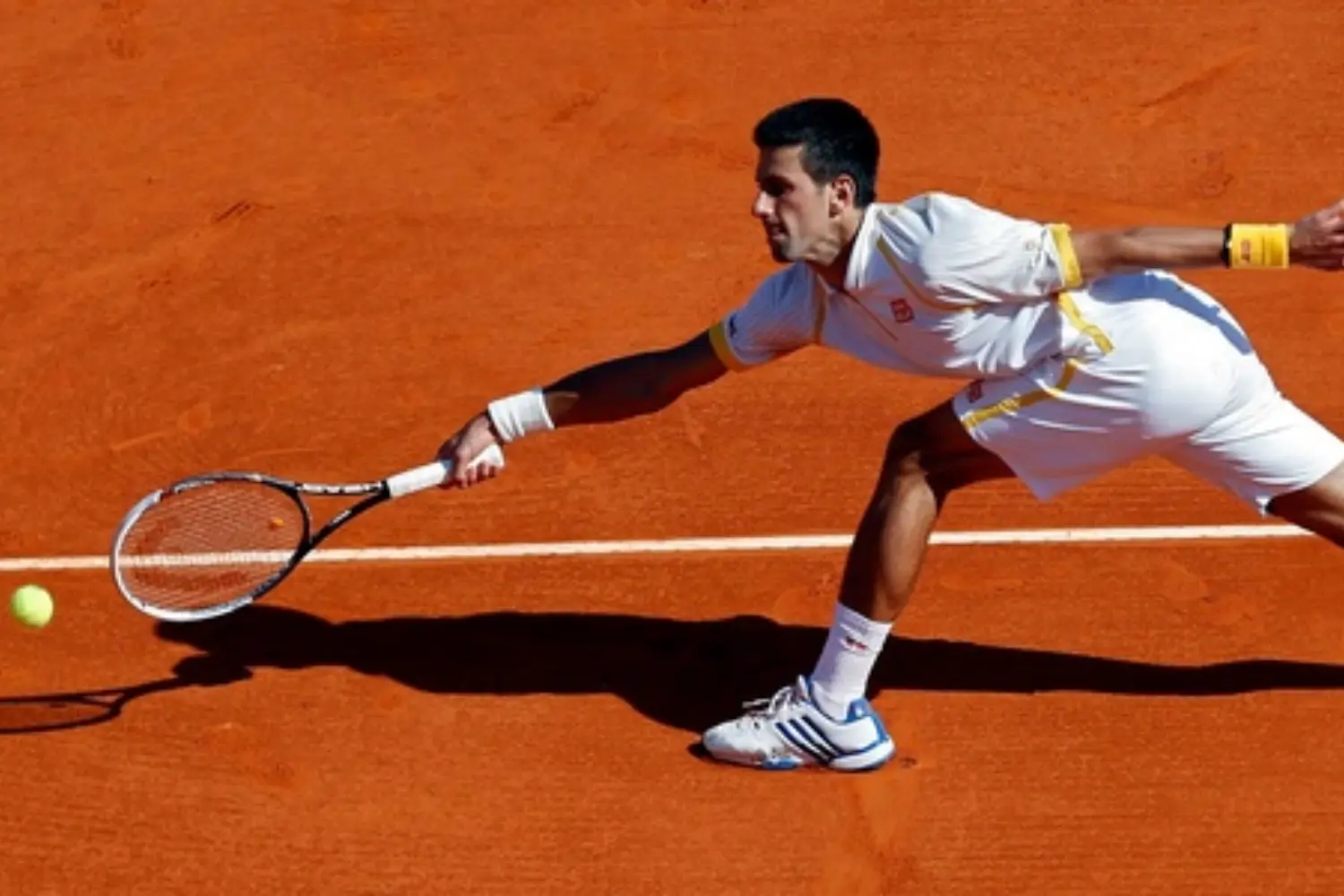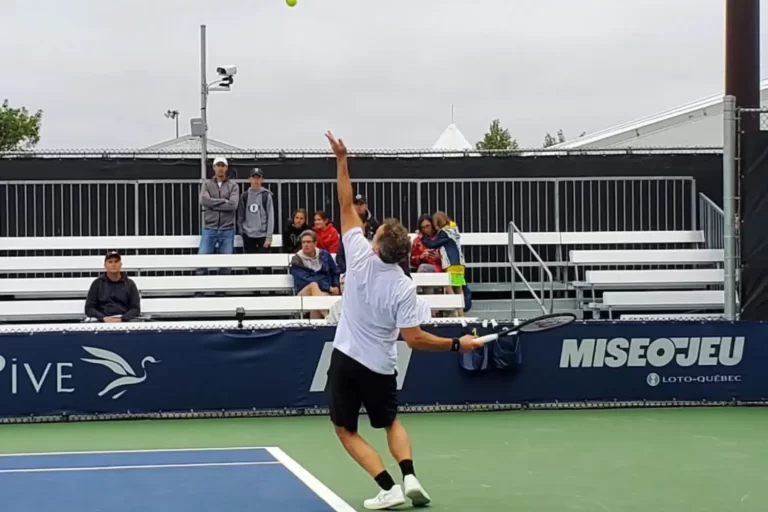What Is A Break Point in Tennis?

In tennis, every point counts. A match can often be decided by a single point.
A routine victory may not always appear this way, but in fact, it may have been impacted by several pivotal moments that could have turned the game, set, or even the match.
It is often more important to win the important points than win the most points overall to determine the outcome of a match.
Tennis matches are dominated by breakpoints.
Their influence can be huge on a match’s outcome, and they often swing momentum in either direction.
Using breakpoints effectively can be the difference between a win and a loss, or it can mean the difference between a draw and a victory.
Due to their capacity to cause rapid upwards and downward spirals, they need to be respected.
Which is the best way to play a break point?
How should you adjust your mental or tactical approach when you return or serve a break point?
Let’s take a closer look at these questions.
What Is A Break Point in Tennis?

It is first important that we understand what is a break point in tennis is before discussing how to play it.
A break point refers to an opportunity for a player serving to lose the service game, and thereby have his or her serve broken.
A returner can break serve on the next point if he wins at least three points in the server’s service game.
Returners will have three break points if the server’s service game is 0-40. There are 3 chances for them to win the next point.
As an example, if the score was 30-40, the returner would only have 1 break point opportunity before the game was cut to two.
Most tennis players, particularly in the professional game, view the serve as their strongest shot because it is the only one they can fully control in tennis.
It doesn’t happen very often that you can win a game on your opponent’s serve.
You can also read The Longest Tennis Rallies
Why Are They So Important

It is often the break point in a tennis match that determines the outcome because it signals the change of momentum.
Service games are generally easier and more predictable to win than returning games.
As the server decides where to serve, they can begin the point whichever way they choose.
A second challenge is returning serve well.
It is the server who ultimately controls the point, as the returner has little control from the outset.
There is no control over the speed, spin, or placement of the serve and they must react accordingly.
It is therefore important to take advantage of breaks of serve when they arise in well matched encounters as they do not happen very often.
In a return match, break points are a great opportunity to turn a match on its head, but they can be a big pressure point for the server.
When you’re facing a break point, it can be quite stressful.
After breaking an opponent’s serve, many players are broken straight back, nullifying the impact of the break of serve.
Hence, players should focus first and foremost on protecting their own serve and controlling what they can.
In general, this is important, but especially at break points in a match.
The outcome of a match depends on these pivotal moments, therefore they should be treated with greater importance than say, a 0-15 point.
Players should play their best tennis at this point in order to reap the rewards on the scoreboard.
You can also read What Is An Ace In Tennis
Serving Break Point
You should stay calm and collected when you are faced with a break point as a server and take a methodical approach to resolve the issue.
You must get your first serve in to save break points.
When it comes to preserving breaks points and ultimately holding serves, this is crucial.
The reality is that this is much easier said than done. When breakpoint is down, the player may be feeling nervous, which can show in their performance.
It only takes a moment of lapse in concentration for an opponent to turn the match in their favor on a break point in an evenly matched match.
You will have the best chance of winning the point by making your first serve, or at least putting pressure on the opponent to make a weaker return that is easier to handle.
The average first serve percentage on break points is hard to match or exceed by many players in the professional game.
Break points are very important for professionals, and they focus on making the most of them.
It is your choice as a server whether or not the point is played on your terms.
The first serve you make is likely to force your opponent to rush into position, or to play a defensive shot.
You can easily save a break point this way rather than hustling and scrambling to stay in a point.
Nonetheless, failing to save a break point drops off a cliff if you need to hit a second serve.
Your opponent has a golden opportunity to pile on the pressure and attack your second serve from a defensive position, so you are quite unlikely to take any major risks on that second serve.
Similarly, your opponent is not affected by losing the point, so they may take more risks and play freely.
The importance of making your first serve as a server at break points cannot be overstated.
It is much more likely that you will win the point by hitting a first serve rather than a second serve, regardless of whether you take your pace off or focus more on placement.
Returning Break Point
Returners should approach break points aggressively while remaining controlled.
These opportunities don’t come around very often, so you should not waste them. Playing passively isn’t a good idea.
A forced or even an unforced error is more likely to be made by your opponent when they’re off balance and feeling under pressure.
In returners with break points, the most important thing is simply to get the return into play.
If you are facing a first serve, a good tactic often involves blocking the ball deep up the middle.
As a result, your opponent is forced to back off, and you have more margin for error. This will likely result in a weaker response from the other player.
A more aggressive and powerful shot can be used to take them of the court and rush them if they’re hitting a second serve.
It’s worth taking this calculated risk, as making your presence known and simply walking inside the court can even prompt a double fault from your opponent.
In order to put pressure on your opponent, returners with break points must remain aggressive, but taper their approach.
If you make the serving player miss, they will almost certainly feel more pressure than you do!
You can also read What Does Suspended Mean In Tennis?
Various types of tennis break points

A returner has a limited amount of chances to break the point before the server ties the game.
Returners have one break point between 30 and 40 when the score is 30-40, and the server ties the game once the returner breaks.
In addition, a double break point is between 15 and 40, and a triple break point occurs between 0 and 40.
Single vs Double vs Triple Break Point
When a returner reaches 40, the server may be on 0, 15, 30, 40, or advantage. Returners in any of those three situations would be on break point, meaning they would win the game and break their serve if they won the next point.
There are three points that could give the returner a break if the server has not won a point yet. This is known as a ‘triple’ break point.
A ‘double’ break point occurs when the server is on 15.
The server, however, must win two points before the returner can break serve in order to reach 30, otherwise the score will become deuce and a second opportunity is needed.
As a result, the break point is called a ‘single’ break point. In the same situation, a returner may move to advantage after winning a ‘deuce’ point.
You can also read Australian Open Tennis 2024 Dates & Schedule
Break Point vs Game Point
As well as gaining an advantage after a deuce if the server reaches 40 before the returner, this is called earning a ‘game point’. Their next point can win them the game.
For an unlimited period of time, the score can oscillate between advantage and deuce in some service games.
The length of these games increases the psychological significance of winning them, since they will often see break points and game points.
A player’s ability to break serve is always important, but holding serve after saving several break points can also be very beneficial.
How Are Break Points Earned?
It is necessary to win one point while your opponent is serving to earn a break point. The most successful players combine skill with strategy and a bit of luck.
During crucial moments of the game, the receiver must outplay the server. For break points to be earned, you must return serves with precision and place the ball strategically.
Faqs
What is the difference between a break and a break point in tennis?
It is therefore known as broken serve when a player is able to win a game despite the disadvantage of having to return serves in his favor. Any point played during a service game where the server is one point away from losing is a break point.
What is advantage of break point in tennis?
As an example, the score could be Love-40. This means that the server has zero points and the receiver has three. It is a breakpoint. Game-winning occurs if the receiver scores the next point. Generally, we use the word ‘advantage’ to refer to the receiver but not to the one who scores points in tennis.
What is the purpose of a break point?
In the developer’s toolbox, breakpoints are an essential tool for debugging. Whenever you want to pause debugging, you set breakpoints. If you want to see how code variables are doing at a certain point, for example, you can check the call stack.
How many points is a breakpoint in tennis?
‘Break points’ are opportunities for players to lose their service games, thus ‘breaking’ their serve. This break serves when the returner wins at least three points in the server’s service game before breaking serve.
Conclusion
Tennis matches are won or lost on break points. It is often these moments that determine the outcome of a match, and they are also where momentum can shift if the right decision is made.
When playing break points, both servers and returners can adjust their approach to produce their best tennis at critical times by understanding this concept.
In order to avoid breaking points, servers should make their first serve as often as possible.
You should aim for spin and placement on your second serve and be more aggressive rather than defensive when hitting it.
In case you return and have earned yourself breakpoints, remember to force your opponent into a mistake if you can.
It’s not a good idea to waste your opportunity but take calculated risks to pile on the pressure and force the issue.
You can also read our guide on How Many Rounds Are In The US Open?





![The Best Tennis Players [Male & Female in 2024]](https://tennisracketnet.com/wp-content/uploads/2023/10/Best-Tennis-Players-768x512.webp)